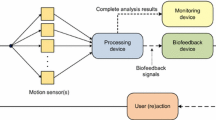Abstract
In the field of physiotherapy, physical therapists assist children with impaired motor functions or congenital loss of limbs to recover their motor functions or to adapt to the use of prostheses controlled by electromyography signals, respectively. However, children often quit training in the use of artificial limbs because it becomes boring with repetition. During a limited time, physical therapists are required to perform many operations on the biofeedback systems in order to personalize them for each user. It is important for children to feel excited about the therapeutic activities. Furthermore, the biofeedback systems should be easy for the therapists to use. In this paper, we propose a building-block-based biofeedback toy called “bioToys.” This system consists of input blocks to receive physical or physiological signals and output blocks to generate different action or effects. This building block system allows users including therapists, children, and their family to program and personalize the biofeedback systems. Finally, we show that by using the developed system, it is possible to control the toys and to record the muscle activities in real time.











Similar content being viewed by others
References
Wolf SL (1983) Electromyographic biofeedback applications to stroke patients. A critical review. Phys Ther. 63(9):1448–1459
Tsubouchi Y, Suzuki K (2010) Biotones: a wearable device for EMG auditory biofeedback. In: Proceedings of annual international conference of the IEEE EMBS, pp 6543–6546
Matsubara M, Kadone H, Iguchi M, Terasawa H, Suzuki K (2013) The effectiveness of auditory biofeedback on a tracking task for ankle joint movements in rehabilitation. In: Proceedings of the 4th interactive sonification, workshop (ISon2013), pp 1–6
Igarashi N, Suzuki K, Kawamoto H et al. (2010) Biolights: light emitting wear for visualizing lower-limb muscle activity. In: Proceedings of annual international conference of the IEEE EMBS, pp 6393–6396
Postema K, van der Donk V, van Limbeek J, Rijken RA, Poelma MJ (1999) Prosthesis rejection in children with a unilateral congenital arm defect. Clin Rehabil 13(3):243–249
Curtis J, Ruijs L, de Vries M, Winters R, Martens JB (2009) Rehabilitation of handwriting skills in stroke patients using interactive games: a pilot study. In: Proceedings of the 27th intl. conf. extended abstracts on human factors in, computing systems, pp 3931–3936
Shimokakimoto T, Ayuzawa S, Suzuki K (2013) Real-time pulse detection for physiotherapy and its application to wearable device (in Japanese). J Inf Process 54(4):1480–1488
Matsubara M, Terasawa H, Kadone H, Suzuki K, Makino S (2012) Sonification of muscular activity in human movements using the temporal patterns in EMG. In: Proceedings of annual summit and conference of APSIPA ASC, pp 1–5
Lund HH, Klitbo T, Jessen C (2005) Playware technology for physically activating play. Artif Life Robot J 9(4):165–174
Hiroshi I, Brygg U (1997) Tangible bits: towards seamless interfaces between people, bits and atoms. In: Proceedings of the ACM conference on human factors in, computing systems, pp 234–241
Lund HH (2003) Intelligent artefacts. In: Sugisaka M, Tanaka H (eds) Proceedings of 8th international symposium on artificial life and robotics, pp I11–I14
Horn MS, Jacob RJK (2007) Designing tangible programming languages for classroom use. In: Proceedings of the 1st intl. conf. on tangible and embedded, interaction, pp 159–162
Schweikardt E, Gross MD (2008) The robot is the program: interacting with roBlocks. In: Proceedings of the 2nd intl. conf. on tangible and embedded, interaction, pp 167–168
Author information
Authors and Affiliations
Corresponding author
About this article
Cite this article
Shimokakimoto, T., Miura, A. & Suzuki, K. bioToys: biofeedback toys for playful and self-determined physiotherapeutic activities. Artif Life Robotics 19, 150–156 (2014). https://doi.org/10.1007/s10015-014-0144-2
Received:
Accepted:
Published:
Issue Date:
DOI: https://doi.org/10.1007/s10015-014-0144-2




